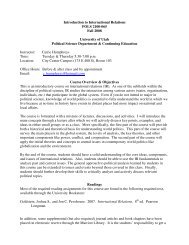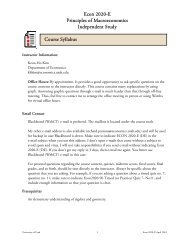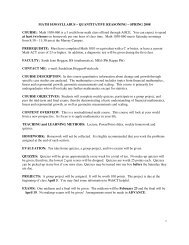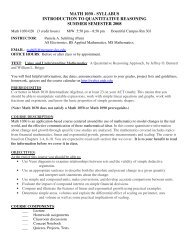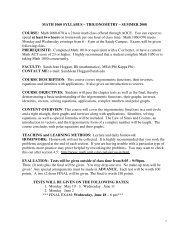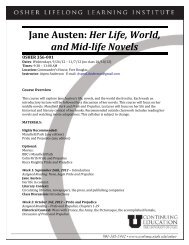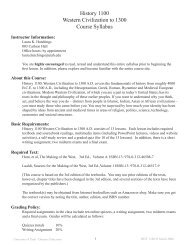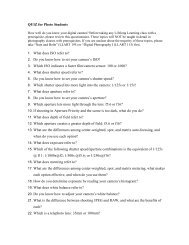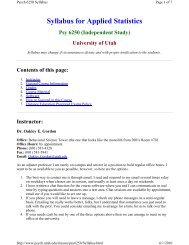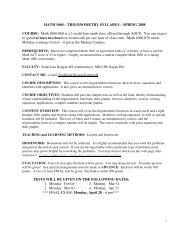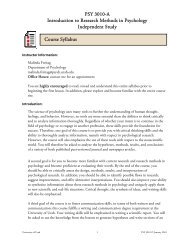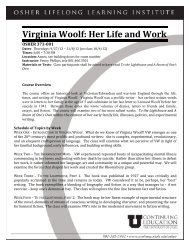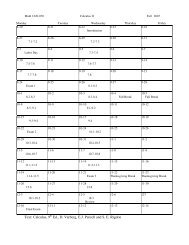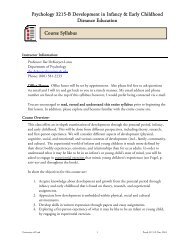Music 3715-D Fine Arts Teaching Methods Course Syllabus
Music 3715-D Fine Arts Teaching Methods Course Syllabus
Music 3715-D Fine Arts Teaching Methods Course Syllabus
You also want an ePaper? Increase the reach of your titles
YUMPU automatically turns print PDFs into web optimized ePapers that Google loves.
<strong>Course</strong> <strong>Syllabus</strong><br />
<strong>Music</strong> <strong>3715</strong>-D<br />
<strong>Fine</strong> <strong>Arts</strong> <strong>Teaching</strong> <strong>Methods</strong><br />
Instructor Information:<br />
Renate Kesler, Ph.D<br />
University of Utah<br />
Department of Distance Education/<strong>Music</strong><br />
Email: RenateKesler@comcast.net<br />
Office Hours: contact me for an appointment<br />
You are highly encouraged to read, reread and understand this entire syllabus prior to<br />
beginning the first lesson. In addition, please explore and become familiar with the entire course<br />
site.<br />
Prerequisites:<br />
None<br />
Basic Requirements:<br />
<strong>Music</strong> <strong>3715</strong>-D Online, <strong>Fine</strong> <strong>Arts</strong> <strong>Teaching</strong> <strong>Methods</strong> – <strong>Music</strong>, consists of seven lessons, each<br />
with an assignment. It also includes two projects (which require teaching music lessons in<br />
elementary school class rooms) and a final examination. The course carries two semester units of<br />
credit through Continuing Education at the University of Utah.<br />
Access to the following is required:<br />
The Internet<br />
*Finale Notepad Trial Version (Download at<br />
http://www.finalemusic.com/NotePad/Demo.aspx. A tutorial is listed in Blackboard.)<br />
**A digital recording device (accepted formats are .wma, .wav, .mp3)<br />
An elementary school class<br />
Current email address that you check often.<br />
Up-to-date computer hardware and software for your PC<br />
*You don’t have to purchase finale notepad but you will need to download the 30-day free trial.<br />
Be sure not to start your 30-day trial until you are ready to use it.<br />
**Some PC’s have built in microphones. If you are using Windows, it is typically located in your<br />
Start Menu/accessories/entertainment/sound recorder. If you are using a Macintosh, Garageband<br />
has a recording feature.<br />
University of Utah 1<br />
<strong>Music</strong> <strong>3715</strong> © September 2010
<strong>Music</strong> <strong>3715</strong>-D<br />
<strong>Course</strong> <strong>Syllabus</strong><br />
<strong>Course</strong> Introduction:<br />
<strong>Music</strong> <strong>3715</strong>, <strong>Fine</strong> <strong>Arts</strong> <strong>Teaching</strong> <strong>Methods</strong> will help future and current elementary school teachers<br />
to integrate music into their classroom. <strong>Teaching</strong> music enriches children’s lives and helps them<br />
succeed better in other areas of the school curriculum.<br />
This course covers music fundamentals as well as materials and methods for teaching music in the<br />
elementary classroom and will provide you with musical knowledge, experience, and confidence. It<br />
is designed for non-music majors and presents a holistic approach to music education. You will<br />
learn how to teach music and also use music as a means of promoting cognitive development<br />
across subject areas.<br />
Required <strong>Course</strong> Materials:<br />
This course requires the following textbook:<br />
Integrating <strong>Music</strong> into the Elementary Classroom (8th Edition) by Anderson, W.M. and J. E<br />
Lawrence. Schirmer Cengage Learning. ISBN: 9780495569855<br />
You will also need access to the <strong>Music</strong> Education Resource Center. If you purchase a new textbook<br />
there should be an access card packaged inside. If you buy a used textbook, you can purchase access<br />
at http://www.cengagebrain.com/shop/en/US/storefront/US?cmd=catProductDetail&ISBN=978-<br />
0-495-57190-2. You can also find this link in the Weblinks tool in Blackboard.<br />
This textbook may be obtained from Internet booksellers such as Amazon or Ebay. Make sure you<br />
get the correct version by noting the title, author, edition, and ISBN number.<br />
<strong>Course</strong> Format:<br />
It is the purpose of this course to provide you with the knowledge and experience necessary to<br />
integrate music into the elementary school curriculum.<br />
There is a great deal of difference between the musical abilities of students in a Kindergarten class<br />
and those in a sixth grade class. To best prepare you for actual teaching, you will need to focus on<br />
one grade as you proceed through this course.<br />
This focus group will be referred to as your “target grade.” If you are not currently teaching or are<br />
un- sure of the grade you would like to teach, either make your best guess or select a middle<br />
elementary grade such as third or fourth. Please only select one grade level. Using your<br />
endorsement designations, such as K-4, as a target grade for this course is too broad. Lessons can<br />
always be adapted later for different situations.<br />
Seven lessons are contained in this course. This course provides commentary that supplements and<br />
further explains the material in the reading assignments.<br />
Intro Quiz/Student Information Sheet:<br />
University of Utah 2<br />
<strong>Music</strong> <strong>3715</strong> © September 2010
<strong>Music</strong> <strong>3715</strong>-D<br />
<strong>Course</strong> <strong>Syllabus</strong><br />
The introduction quiz is designed to help you become familiar with important aspects of<br />
the course. You must pass the quiz with 100% to view any course lessons. You may take<br />
the quiz as many times as needed. It covers material in the syllabus and Start Here folder.<br />
Also you must complete the Student Information Sheet located in lesson 1. You will not<br />
be able to submit any assignments until this has been completed.<br />
Assignments:<br />
Each of the seven assignments is designed to help you understand musical terminology,<br />
obtain musical skills, and integrate them within your classroom. Assignments must be<br />
submitted in the order re- quested and must be typed and double-spaced unless<br />
otherwise noted. Please contact the instructor if you have any questions about the<br />
assignments or course material.<br />
All assignments must be submitted through the assignments submission tool in<br />
Blackboard.<br />
Lesson Plans:<br />
I believe that the best way to gain competence in teaching music is through participation<br />
in actual teaching experiences. Therefore, you will create a lesson plan as part of each<br />
assignment. Writing these lesson plans will give you opportunities to push the creative<br />
envelope. I will give you feedback for improving each lesson you create so don’t worry<br />
that you don’t yet know enough about music to write meaningful lesson plans. Your first<br />
few plans will be graded mostly on effort and format so just dive in and do your best!<br />
You will learn quickly.<br />
The format to use in preparing these plans is given to you in lesson 1. You must use this same<br />
format for each lesson plan, and each one must be typed and double-spaced. SAVE COPIES<br />
OF ALL OF YOUR LESSON PLANS! They will assist you in completing the two<br />
projects, and will also be an in- valuable resource for you as a teacher in your own<br />
classroom. It is strongly suggested that you compile these lesson plans into an organized<br />
notebook so that you can easily locate and implement them in the future. Then you will<br />
walk into your own classroom with several complete and useful music lesson plans — a<br />
major head start!<br />
Projects:<br />
Your first project consists of one 30-minute teaching visit to an elementary school<br />
classroom. The class should be your target grade. During this visit, you will use one of<br />
the lessons you designed and submit- ted as part of assignments 1-4 to teach to the class.<br />
You may not submit project I until assignments 1-4 have been graded and returned to<br />
you. Upon completion of this teaching visit, you will submit a detailed self-evaluation,<br />
the original lesson plan and revised lesson plan. Be sure to highlight any revisions!<br />
Complete instructions for project I follow lesson 4 in this course manual.<br />
University of Utah 3<br />
<strong>Music</strong> <strong>3715</strong> © September 2010
<strong>Music</strong> <strong>3715</strong>-D<br />
<strong>Course</strong> <strong>Syllabus</strong><br />
Project II also consists of one 30-minute teaching visit to an elementary school<br />
classroom. This class should be your target grade. If possible, return to the classroom<br />
where you completed your first project. During this visit, you will use one of the lessons<br />
you designed and submitted as part of assignments 5-7 to teach to the class. Upon<br />
completion of this teaching visit, you will submit a detailed self-evaluation, the original<br />
lesson plan, and revised lesson plan. Be sure to highlight any revisions! You may not submit<br />
project II until assignments 5-7 have been graded and returned to you. Complete<br />
instructions for project II appear at the end of lesson 7. Also, the host teacher has to fill<br />
out a form for both projects I and II, located at<br />
http://continue.utah.edu/distance/music<strong>3715</strong>. This form must be filled out by the<br />
host teacher and not the student.<br />
Final Exam:<br />
The final exam is comprehensive and so covers all course material found in Blackboard.<br />
A matching exercise, short answer, and essay questions are included. You may take the<br />
final only after all assignments and both projects have been graded and returned to you.<br />
To help you prepare for the exam, a study guide has been provided in Blackboard located<br />
at the end of lesson 7 and under the “start here” link on the home page. Allow two hours<br />
to take the exam.<br />
Please feel free to email me if you have any questions during this course. My email<br />
address is listed at the top of this syllabus.<br />
The final exam is electronic so you will need access to a computer with Internet.<br />
Students are required to make their own exam arrangements, which must meet the<br />
requirements of the Distance Education Office (i.e., through a university or college<br />
testing center). This has to be done several weeks before the exam - so it is recommended<br />
that you plan accordingly! To take an exam, you will need to submit an Exam Request<br />
Form through Distance Education. The Distance Education Office will assist with<br />
arrangements, but cannot guarantee that arrangements can be made. In addition, there<br />
are costs associated with proctors and the amounts vary depending on the institution. If<br />
you have any questions regarding exams, please contact the Distance Education office at<br />
(800) 467-8839 or email at distance@aoce.utah.edu. For further information see the<br />
“Final Exam Request” link on the <strong>Music</strong> <strong>3715</strong> homepage in Blackboard.<br />
You must pass the Final Exam in order to pass the course. If you fail this exam, you<br />
will fail the course. This is a requirement of U of U Distance Education courses.<br />
<strong>Course</strong> Policies:<br />
Grading:<br />
University of Utah 4<br />
<strong>Music</strong> <strong>3715</strong> © September 2010
<strong>Music</strong> <strong>3715</strong>-D<br />
<strong>Course</strong> <strong>Syllabus</strong><br />
Assignments (7 total)<br />
Project 1<br />
Project 2<br />
Final Exam<br />
700pts<br />
240pts<br />
240pts<br />
100pts<br />
Total: 1280 pts<br />
Your final grade is determined using the following point totals:<br />
A 93-100% C 73-76%<br />
A- 90-92% C- 70-72%<br />
B+ 87-89% D+ 67-69%<br />
B 83-86% D 63-66%<br />
B- 80-82% D- 60-62%<br />
C+ 77-79% E Below 60%<br />
What Successful Students Should Expect To Do In This <strong>Course</strong>:<br />
Successful students follow instructions. The syllabus, lectures and assignments are the primary<br />
sources of instructions in any college course; so successful students read them carefully and refer<br />
to them regularly.<br />
Successful students write down any instructions given by the professor; they are also careful to<br />
make sure that they have taken accurate notes and ask questions.<br />
Successful students look up information first so that they ask informed questions, not questions<br />
they already have the answers to. If they can’t find the answers, they contact the instructor.<br />
Successful students pay close attention to how they can best and most easily learn the material in<br />
a particular subject area.<br />
Your <strong>Course</strong> Responsibilities:<br />
This course requires significant self-motivation. Lessons take several hours to complete. Don’t<br />
try to do them in one day. Please note that not all lessons are created equal. Some may take a bit<br />
more time than others.<br />
You would normally spend 3± hours per week in “class” for this course. Allow yourself several<br />
hours to complete the lessons on-line, including the time spent writing to discussion boards,<br />
assignments, and other required activities. You should plan additional time to read the text and<br />
study for the quizzes. In the beginning, the lessons will probably take longer than they will once<br />
you are familiar with the system.<br />
University of Utah 5<br />
<strong>Music</strong> <strong>3715</strong> © September 2010
<strong>Music</strong> <strong>3715</strong>-D<br />
<strong>Course</strong> <strong>Syllabus</strong><br />
Some people believe this a much easier way to study this subject than in the on campus<br />
framework because they love to read and avoid parking problems. Others may feel very<br />
intimidated at first. Be patient as you work your way through the first few lessons. If you are<br />
serious about the material, you will learn as much or more than most on campus students about<br />
this subject and develop reading and communication skills that are vital to the workforce of the<br />
21st century.<br />
Planning Time:<br />
Successful students (those that get A’s, B’s, and C’s) use their time wisely. Just like a face-to-face<br />
course, the standard formula for college coursework is that for every one hour of class time will<br />
result in three to six hours (and sometimes more) of homework; so a three-unit course will<br />
require an average of 9 or more hours of homework (reading, research, studying) per lesson. As a<br />
result, successful students plan their time wisely so that they keep up with assignments by<br />
maintaining a pace that fits the course schedule. They also communicate with the instructor<br />
often so that they can receive much needed feedback on their work.<br />
Online <strong>Course</strong> Responsibilities:<br />
This course requires significant self-motivation. Some lessons take a considerable amount of time<br />
to complete. Please note that not all lessons are created equal. Some may take a bit more time<br />
than others. Some people believe this to be a much easier way to study this subject than in the<br />
on-campus framework. Others may feel very intimidated at first. Be patient as you work your<br />
way through the first few lessons. If you are serious about the material, you will learn as much, if<br />
not more, than most on-campus students about this subject and develop reading and<br />
communication skills that are vital to the workforce of the 21st century.<br />
The following is a list of general notes as they relate to the course:<br />
All course communication with the instructor should be completed using the email listed<br />
at the top of the syllabus.<br />
Assignments are to be submitted in Word format ( .doc or .docx)<br />
The exams will be proctored. Refer to the Distance Education Office web site or the<br />
Final Exam Request link in Blackboard for further information.<br />
Online Courtesy & Communication Policy:<br />
Extreme consideration for the feelings of others is expected. People cannot see you smile and<br />
may not know when you are joking. Do not tell people they are stupid or wrong. Do explain<br />
why you believe differently. If someone has the facts wrong, direct them to the source of accurate<br />
information or politely offer your alternative “facts.” Use of profanity or direct/indirect insults<br />
which defame a person’s character, race, ethnicity, religion, etc. are inappropriate and will not be<br />
tolerated.<br />
University of Utah 6<br />
<strong>Music</strong> <strong>3715</strong> © September 2010
<strong>Music</strong> <strong>3715</strong>-D<br />
<strong>Course</strong> <strong>Syllabus</strong><br />
Academic Dishonesty & Plagiarism:<br />
Cheating will not be tolerated in this course. Anyone caught cheating will fail the course and will<br />
be reported to the Associate Vice President for Academic Affairs, in accordance with the Code of<br />
Student Rights and Responsibilities.<br />
Successful students always make sure that their work is original. This is important because the<br />
instructor must be able to gauge what the student has learned. Therefore, copying the work of<br />
another person, whether an essay, answers on your assignments or during a test, is considered<br />
plagiarism.<br />
Plagiarism is a form of cheating. Any time a student uses someone else’s work and does not give<br />
that person credit, it is plagiarism. Anyone who plagiarizes will receive a failing grade on the<br />
assignment. If this is repeated, the student will fail the course and can be expelled from the<br />
university. If you are “suspected” of plagiarism, you will bear the burden of proof. You must be<br />
able to present rough drafts or related materials and discuss the topic intelligently. Refer to the<br />
University of Utah Plagiarism Policy for more details and/or the University of Utah - Policy and<br />
Procedures Manual.<br />
ADA Policy:<br />
The University of Utah seeks to provide equal access to its programs, services and activities for<br />
people with disabilities. If you will need accommodations in the course, reasonable prior notice<br />
needs to be given to the Center for Disability Services (CDS), 162 Olpin Union Building, 581-<br />
5020 (V/TDD). CDS will work with you and the instructor to make arrangements for<br />
accommodations.<br />
All written information in this course can be made available in alternative format with prior<br />
notification to the Center for Disabilities.<br />
THE INSTRUCTOR RESERVES THE RIGHT TO CHANGE/MODIFY<br />
THE CONTENTS OF THIS SYLLABUS<br />
COPYRIGHT NOTIFICATION<br />
Copyright notice to students taking online courses:<br />
Notice to students that materials used in connection with the course may be subject to copyright<br />
protection.<br />
TEACH Act Copyright Notice<br />
The materials on this course Web site are only for the use of students enrolled in this course for<br />
purposes associated with this course and may not be retained or further disseminated.<br />
University of Utah 7<br />
<strong>Music</strong> <strong>3715</strong> © September 2010



